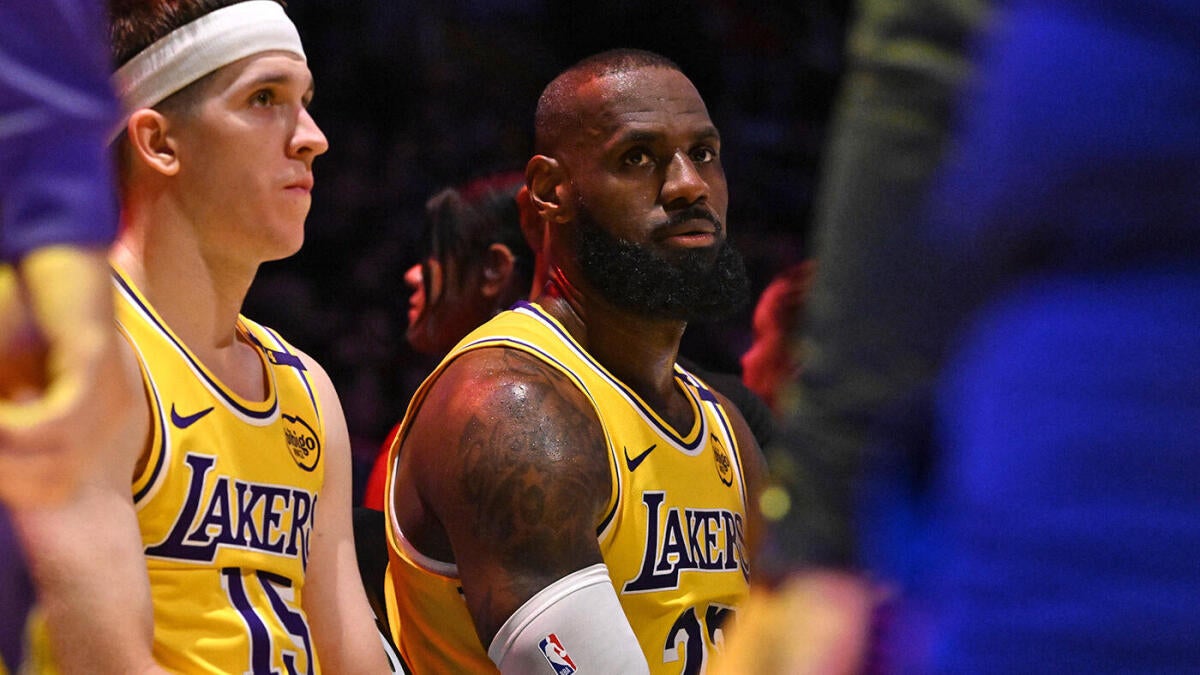The Lakers’ Crossroads: A Deep Dive into the Center Crisis and Beyond
The Centerless Strategy: A Glaring Weakness
The Los Angeles Lakers’ first-round playoff exit to the Minnesota Timberwolves has left fans and analysts alike questioning the team’s strategy, particularly the conspicuous absence of a reliable center. The Lakers’ decision to forgo a traditional center has been a contentious topic, and the playoffs exposed this strategy’s shortcomings. The Timberwolves’ size and physicality overwhelmed the Lakers, with the absence of an impactful big man evident on both ends of the court. The Wolves dominated the rebounding battle and scored more points in the paint, exploiting the Lakers’ lack of a formidable presence in the middle.
LeBron James, the Lakers’ star forward, was the tallest player on the floor during Game 5, standing at 6-foot-9. When asked about the team’s shift to a smaller lineup post-game, LeBron deflected the question, making a sarcastic remark about former teammate Anthony Davis’ trade. This evasion underscored the Lakers’ glaring issue and the lack of a clear answer from the team’s leadership. The centerless strategy, while innovative, proved to be a significant liability in the playoffs, leaving the Lakers vulnerable to teams with more traditional lineups.
The Anthony Davis Factor: A Wounding Blow
The trade of Anthony Davis to the Timberwolves added another layer of complexity to the Lakers’ center crisis. Davis, who was expected to be the franchise’s cornerstone at the center position, left the team in a difficult situation. His departure forced the Lakers to adapt their strategy hastily, further complicating their efforts to build a cohesive and competitive roster. LeBron’s post-game jab at Davis highlighted the frustration within the team, as the Lakers struggled to find a suitable replacement for their former star.
The Lakers’ lack of depth at the center position was a known issue heading into the postseason. However, their inability to address this weakness proved costly. The Timberwolves, with their versatile lineups, capitalized on the Lakers’ vulnerability, leading to a swift and decisive first-round exit. The absence of a reliable center was a significant factor in the Lakers’ downfall, as they struggled to match the Timberwolves’ physicality and size.
LeBron’s Future: A Pivotal Moment
At 40 years old, LeBron James finds himself at a career crossroads. His future with the Lakers is uncertain, and his evasiveness regarding questions about his future adds to the franchise’s uncertainty. The Lakers had hoped to combine LeBron’s experience with a younger, more dynamic roster, but the team’s lack of cohesion and depth proved to be a significant obstacle. As the Lakers enter the offseason, the next few months will be crucial in determining the franchise’s direction and LeBron’s role in it.
LeBron’s decision to return for another season or retire after his 22nd NBA campaign will significantly impact the Lakers’ future. The team’s lack of depth and the center crisis need to be addressed urgently, and LeBron’s presence or absence will play a significant role in shaping the franchise’s trajectory. The Lakers’ offseason will be a critical period, as the team seeks to rebuild and redefine its identity in the wake of their playoff exit.
The Timberwolves’ Advantage: Physicality and Size
The Timberwolves’ physicality and size were too much for the Lakers to handle. Minnesota secured a 103-96 victory in Game 5, with Rudy Gobert leading the charge. The three-time Defensive Player of the Year finished with a career-high 27 points, showcasing his dominance on both ends of the court. The Timberwolves’ ability to switch between big and small lineups proved to be a significant advantage, as they exploited the Lakers’ weaknesses with ease.
The Lakers’ inability to match the Timberwolves’ physicality and size was a key factor in their first-round playoff exit. The Wolves’ depth and versatility allowed them to overwhelm the Lakers, particularly in the paint and on the boards. The Lakers’ centerless strategy, while innovative, proved to be a significant liability against a team like the Timberwolves, who were well-equipped to exploit their weaknesses.
The Road Ahead: Finding Direction
The Lakers’ center crisis and LeBron’s evasiveness regarding the team’s strategy have left the franchise at a critical juncture. The Timberwolves’ physicality and size exposed the Lakers’ lack of depth and a reliable center, leaving the team directionless and drained as they enter the offseason. The next few months will be pivotal in determining the Lakers’ trajectory, with LeBron’s future and the team’s strategy under intense scrutiny.
The road ahead is uncertain, but one thing is clear: the Lakers must address their center crisis and find a direction that will lead them back to the top. The franchise’s future hangs in the balance, and the decisions made in the coming months will shape the Lakers’ identity for years to come. As the team seeks to rebuild and redefine itself, the spotlight will be on the Lakers, with fans and analysts alike eager to see how the franchise navigates this challenging period. The Lakers’ journey back to the top will be fraught with obstacles, but with the right decisions and a clear vision, the team can once again become a force to be reckoned with in the NBA.












